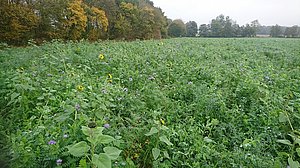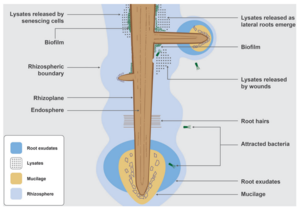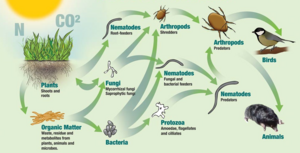Integrating Biology and Chemistry for Crop Production

When we begin to unpack the complex world of soil, of course there are many factors that contribute to the optimum functioning of a ‘healthy soil’ – be that chemical, physical or biological. That said, it is clear that soil biology specifically has played an instrumental role in catalysing the recent interest in soil health and with good reason – soil biological interactions are key in driving so many critical soil functions – be that nutrient cycling for plant uptake1, maintaining of soil aggregates and structure2, improving gas and water interactions2, protecting the plant from pests and disease3,4 and building organic matter5,6. Consequently, microbes are undoubtedly the unseen engine of soil fertility, and plant growth ultimately depends on a variety of functions performed by these diverse soil and root dwelling organisms. Let’s be clear however, there are many knowledge gaps and much to learn, we still know so little – particularly about the ‘micro’ part of soil biology – but this microbiome represents a major untapped resource with extraordinary potential to help improve our production systems. Using this vast diversity of microbial allies, production systems of the future will deploy a combination of targeted inoculants coupled with specific strategies to manage this biome toward supplying nutrients, deterring crop pests and building soil fertility over time in a much more biologically driven and sustainable fashion than we do presently.
Some simple management strategies that can be implemented on farm to improve soil biological function include:
- Maintaining a living root
- Keeping the soil covered with living plants ensures roots and root exudates are constantly feeding and supporting soil biota. Continuous cropping, green manures or use of off-season cover crops are ideal.
- Organic amendments
- Composts or manures inoculate soils with beneficial biology as well as providing a medium of carbon and nutrients that aids establishment and ongoing functionality.
- Biofertilisers
- Composts and manures provide a more diverse inoculant but there may be a time and place for specific cultured inoculants for a more targeted response. The use of rhizobia with legumes or mycorrhizal fungi with tree crops would be good examples of current success stories, but beyond these, the options are as vast as the microbiome itself.
- Plant species diversity
- The use of cocktail cover crops, multi-species pastures and intercropping have all been demonstrated to enhance soil biological function.
- Minimising soil disturbance
- The use of no till, min till or strip till all help to minimise the physical disruption to the soil habitat.
- Minimise excessive inputs
- Excessive use of fertilisers or pesticides can compromise biological function.
As important as soil biology is, it still has to function within the soil matrix, equally a chemical and physical world. Consequently, we must still frame discussions on biology within this broader context, it is an interaction, after all. A soil chemistry test is a common tool that most farmers can use to manage their chemical fertility so let’s consider a few important factors where chemistry and biology intersect. Soil chemistry is equally a complex topic and there is endless reading out there on this topic so rather than reinvent the wheel, I’ll just say a few points – perhaps a detailed discussion on soil chemistry is something that can be revisited in future.
It is common in many parts of the world for standard soil analyses to only test for a handful of parameters – major nutrients and pH for example. However, a limitation or imbalance of any one of the essential nutrients can impact plant growth and development so it is prudent to ensure that both macro and micro minerals are all tested [at least somewhat routinely]. Don’t forget the lesser considered traces also – molybdenum, cobalt and nickel for example. These nutrients all have an important role in nitrogen metabolism and fixation. On that point, often overlooked is the fact that microbes in the soil need nutrients too – all the same macro and micro minerals. We focus so heavily on plant requirements but again using the example of Mo, Co and Ni – N fixing bacteria cannot fix atmospheric nitrogen without these important minerals and a limited supply to the bacteria can limit the overall potential of nitrogen fixation to the crop.
Most soil analyses will typically measure the plant available fractions of tested elements; however, soils contain significant additional reserves of minerals which are not necessarily, plant available, but still present, nonetheless. This pool of nutrients is typically referred to as the total pool and often exceeds the plant available fractions by tenfold or more. These total nutrients are insoluble, often locked up and consequently unavailable to the plant7. However, soil microorganisms have a myriad of strategies and modes of action to unlock and solubilise these total nutrients by excreting specialist enzymes and acids that strip the minerals off the soil matrix, releasing them for subsequent plant uptake8,9. Herein lies one of the key reasons why implementing strategies to improve soil biological function can help reduce dependency on fertiliser inputs – by liberating these total reserves. Many farmers around the world who have shifted their focus to soil biology are succeeding in cutting fertiliser inputs and still maintaining profitability. Of course, strategies like this should be undertaken within the context of the inherent soil type and environmental setting and as was discussed in the previous issue of terraHORSCH, an integrated approach that focusses on many different strategies is typically the best path forward.
References
- Protists: Puppet Masters of the Rhizosphere Microbiome. (2018). doi:10.1016/j.tplants.2018.10.011.
- Soil as an extended composite phenotype of the microbial metagenome. (2020). doi: 10.1038/s41598-020-67631-0
- Organic management promotes natural pest control through altered plant resistance to insects. (2020). doi: 10.1038/s41477-020-0656-9
- Managing and manipulating the rhizosphere microbiome for plant health: A systems approach. (2017). doi: 10.1016/j.rhisph.2017.04.004
- Quantitative assessment of microbial necromass contribution to soil organic matter. (2019). doi: 10.1111/gcb.14781
- The importance of anabolism in microbial control over soil carbon storage. (2017). doi: 10.1038/nmicrobiol.2017.105
- Opportunities for mobilizing recalcitrant phosphorus from agricultural soils: a review. (2018). doi: 10.1007/s11104-017-3362-2
- Phosphate solubilizing microbes: Sustainable approach for managing phosphorus deficiency in agricultural soils. (2013). doi: 10.1186/2193-1801-2-587
- Phosphate-Solubilizing Microorganisms and Their Emerging Role in Sustainable Agriculture. (2019). doi:10.1016/b978-0-12-816328-3.00017-9.


